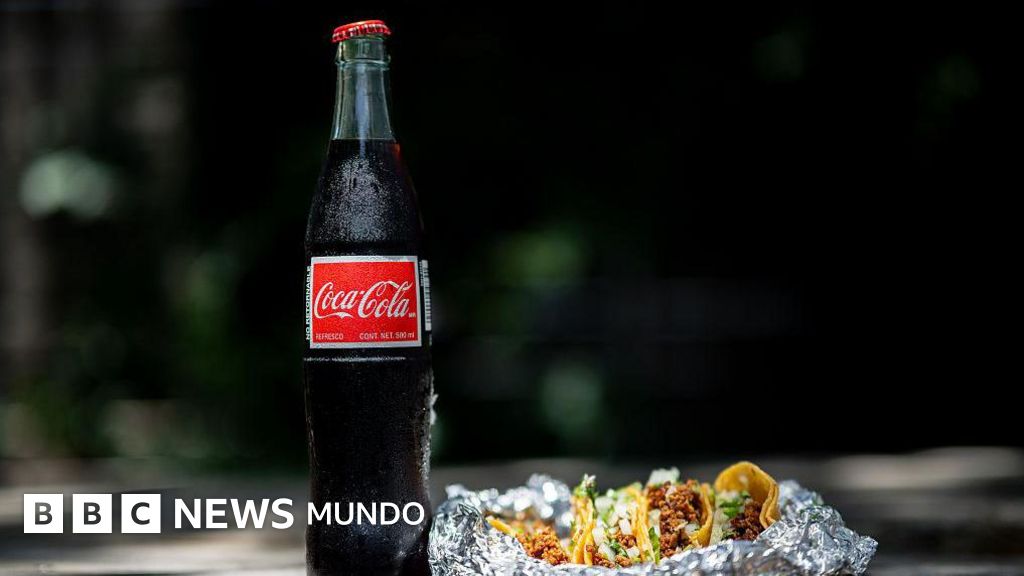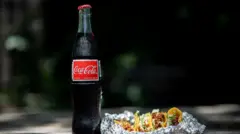

Image source, Getty Images
When was the last time you took a Coca-Cola? And in doing so, did you notice what was sweetened?
Maybe you didn't know it, but the world's best known soda company uses different recipes of its iconic drink depending on the territory in which it is sold.
“The main reason is that countries have different ways, from the agronomic point of view, to produce the cheapest sweetener,” Parke Wilde, food economist at the University of Tufts (USA), tells BBC world.
“And in the United States, that is achieved from corn or beets of sugar.”
As the US is the main corn producer in the world, many food companies in the country-including Coca-Cola-are much cheaper to sweeten their foods with high fructose corn syrup-a very sweet flavor liquid derivative that is extracted from corn-than with cane sugar.
This has led to Coca-Cola to face an unexpected competitor in the US territory: the Mexican coca-cola, brought from the southern neighbor because many consumers, as President Donald Trump said, “it is simply better” thanks to cane sugar.
In fact, a few days ago Coca-Cola reported that, as Trump had previously asked, he would also start producing and also selling in the US his most emblematic drink sweetened with cane sugar, in addition to continuing with that of corn syrup.

Image source, Getty Images
But how true is that high fructose corn syrup is worse for health than cane sugar?
To find the answer, BBC Mundo spoke with Kathleen Melanson, nutritionist and director of the Energy Balance Laboratory of the Rhode Island University, and with Professor Parke Wilde.
Why is Coca-Cola sweetened differently in the US?
Professor Wilde explains that in the US, corn and sugar beet dominate crops, and the cane only really thrives in areas such as Florida and Louisiana.
This productive map makes corn syrup more economical and a better option for the American food industry.
Logistic advantages also weigh, explains Professor Melanson: “As high fructose corn syrup is liquid, it is easy to transport and mixes well, so it is ideal for mass manufacturing processes of drinks.”

Image source, Getty Images
For a manufacturer, Melanson explains, it is convenient, since the sugar is already in solution, which facilitates precisely dose and maintain homogeneity in the different lots.
Replace corn with cane sugar would also face an infinity of internal limitations.
The ability to significantly expand cane cultivation in the US is reduced by agroecological and environmental reasons. Not all regions offer the appropriate temperature and cultivation cycle, explains Wilde, and in southern Florida, for example, the use of soil competes with sensitive ecosystems.
Replacing corn syrup with sugar would imply, in that case, an increase in imports from sugar countries, which would increase the production chain and collide with policies that have protected local producers with tariffs and quotas for decades.
Trump's interest in the discussion, in addition, faced corn and sugar lobbying groups.
Although both industries have a certain influence in Washington, Wilde explains that “the US is configured to produce cheap sweetener from corn.”
“By cost, logistics and scale, that was the path that the beverage industry consolidated since the seventies.”
What is corn syrup and how differs from cane sugar?

Image source, Getty Images
The cane sugar (or beet) that reaches the table is called sucrose. Chemically, it is a molecule formed by glucose and fructose in a proportion of 1: 1, together with each other. That union breaks during digestion and both simple sugars are released.
The corn syrup starts from the corn starch, which is composed of long glucose chains. Experts explain that in the industrial process, these chains are broken until free glucose obtain and then a part becomes fructose.
For soda, the typical mixture is approximately 55% fructose and 45% glucose.
That proportion is not accidental. “Fructose is the sweetest monosaccharide; so the industry points to that percentage to achieve a sweetness marked with a manageable volume,” Melanson explains.
In practice, the comparison between corn syrup and sucrose is reduced to two details: a slight difference in the distribution of sugars and a different physical state (liquid vs. solid) when entering the recipe.
From the point of view of the consumer, both are caloric sugars. The label can say “sugar” or “corn syrup”, but what reaches the organism are glucose and fructose that the body metabolizes by known paths.
Is cane sugar better for health than corn syrup?

Image source, Getty Images
Dr. Melanson says that part of the discredit to the high fructose corn syrup is based on a hypothesis of what happens in metabolism when consuming it: having a little more fructose than sucrose and being freely, the syrup could be absorbed faster and, in high doses, saturate the liver path that processes fructose, forcing it to become fat.
To explain it, Melanson says that you can compare the amounts of fructose that occur naturally in a fruit (between 5 and 10 grams) and the amount consumed of a single blow when a soda is taken, about 40 grams in a large glass: “The liver is not designed to process that amount of sugar at once.”
This indicates that, beyond the type of sugar that is consumed, the important thing is the amount of sugar in general that is included in the diet.
Melanson has made comparisons of studies that investigate the effects of both sucrose and corn syrup on the body and says there is a minimal difference in sugars levels: “We did not see large short -term differences,” he says.

Image source, Getty Images
Wilde, from the feeding economy, agrees on the diagnosis: “Dietary guides recognize both as added sugars and, therefore, it is not recommended to comsume them excessively.”
Melanson also highlights an issue that is independent of the sweetener: sugary drinks satia. “It is easy to overcome liquid calories without feeling full,” he warns.
That imbalance helps to explain why, even in countries that do not use corn syrup, obesity is also a challenge: the format matters as much as the ingredient.
In that sense, the “Mexican Coca-Cola” can know us different-some, better-, but it is not a nutritional safe-conduct. Changing from syrup to cane does not transform a soda into a healthy option; Just change the type of sugar that sweetens it.
Best practices regarding sugar consumption

Image source, Getty Images
The advice that comes from both experts is consistent with scientific evidence: we must reduce added sugars in general.
“The sensible strategy is to lower the total sugars added,” says Melanson. In practice, that means less sugary drinks and less ultraprocessed foods, which are the ones that tend to use corn syrup and other sweeteners.
Melanson proposes to look at the complete pattern of the diet rather than focus on a single product. In addition, the quantities are key: “It is not the same a sporadic portion as a daily habit,” he explains.
Wilde invites us to expand the repertoire of hydration, including less sweet water and drinks to unlock the palate of intense sweetness. It is not about prohibiting, but about improving habits about what we drink.
And that is why choosing between cane and syrup is a minor decision against the background. The guides in the US have been insisting that the population consumes more sugar added than the advised, regardless of whether it is corn or sucrose syrup.
For those who like a Coca-Cola from time to time, Melanson offers a practical criterion: pay attention to frequency and context.
“If it is very uncommon, there is no reason for alarm. What matters is how much added sugar there are throughout the diet.” That approach will reduce anxiety to find the best Coca-Cola.

Subscribe here To our new newsletter to receive every Friday a selection of our best content of the week.
And remember that you can receive notifications in our app. Download the latest version and act.







